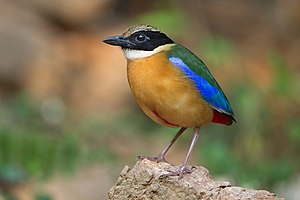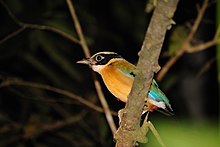Blue-winged Pitta
| Blue-winged Pitta | ||||||||||||
|---|---|---|---|---|---|---|---|---|---|---|---|---|

Blue-winged Pitta ( Pitta moluccensis ) |
||||||||||||
| Systematics | ||||||||||||
|
||||||||||||
| Scientific name | ||||||||||||
| Pitta moluccensis | ||||||||||||
| ( Statius Müller , 1776) |
The blue- winged pitta , also known as the little blue-winged pitta ( Pitta moluccensis ), is a passerine of the genus Pitta within the family of the Pittas (Pittidae). The species occurs in back India , southwest China , the Great Sunda Islands and the Philippines . As stray visitors , you will also find yourself again and again on Christmas Island and on the west coast of Australia , where otherwise only the rainbow pitta is represented from the Pittas family . No subspecies are distinguished for this species . It is only a resident bird in the extreme south of the Malay Peninsula . The wintering areas include Sumatra and Borneo . The blue-winged pitta also breeds on the latter island.
features
Blue-winged pittas reach a body length of 18 centimeters to 19.6 centimeters, of which 3.6 to 4.1 centimeters are due to the tail plumage. The beak measures between 2.9 and 3 centimeters measured from the skull. The barrels have a length of 3.6 to 4.1 centimeters. the middle front toe is 2.9 to 3.3 centimeters long including the claw. The weight is between 56 and 70 grams.
In adult birds, the vertex is black, above the eye there is a broad, dark isabel-colored to light reddish-brown stripe, the individual feathers of this stripe have lighter tips. The reins, the sides of the face and the back neck are black. The shoulders and back are dull dark green, the torso is bright blue-violet. The elytra are bright blue, with individual feathers having a green tip. The hand and outer arm wings are black with a large white spot in the middle. The tail is black with a blue-green tip. The chin and throat are white. The neck, chest and flanks are light cinnamon brown to reddish cinnamon brown. The middle of the abdomen, the rump and the under tail cover are bright red. The tail is black on the underside.
The females are colored similarly to the males, but their coloring is a little more dull.
The blue-winged pitta has a long and pointed black beak. Their eyes are large with reddish brown to dark brown irises , and their feet are dark pink to pale brown.
food
The blue-winged pitta mainly eats invertebrates . It finds its food mainly on the ground. It also eats shell snails.
Way of life
Blue-winged pittas are calm ground birds that sleep on trees. They build their spherical nest, which consists of stalks, moss, leaves and plant fibers, on the ground. The female lays three to four eggs and the incubation period is about 14 days.
Position within the family
The blue- winged pitta forms together with the great blue-winged pitta ( Pitta megarhyncha ) a super species . The great blue-winged pitta, also called the mangrove pitta, occurs from Bangladesh to Sumatra . The blue-winged pitta has long been classified as a subspecies of the great blue-winged pitta. However, it differs in physique, plumage and behavior and also occupies a different ecological niche. So far, no natural hybrids have been found between the two species where the two species overlap.
Keeping as an ornamental bird
Blue-winged pitta are very demanding ornamental birds that should only be looked after by experienced keepers. However, because of their attractive body plumage, they are occasionally seen in large aviaries in zoos.
Etymology and history of research
Philipp Ludwig Statius Müller described the blue winged pitta under the name Turdus Moluccensis or blood wing , which came from the Moluccian islands.
The term "Pitta" means "pretty ornament" in Telugu . Louis Pierre Vieillot (1748–1830) introduced the new genus for all birds, which Philippe Guéneau de Montbeillard (1720–1785) described in 1775 as Les Brèves . The specific epithet »moluccensis« refers to the place where this species was found, the » Moluccas «.
literature
- James A. Jobling: Helm Dictionary of Scientific Bird Names . Christopher Helm, London 2010, ISBN 978-1-4081-2501-4 .
- Philipp Ludwig Statius Müller: The knight Carl von Linné royal Swedish personal physician uu complete natural system. Volume of supplements and registers covering all six parts or classes of the animal kingdom. Made out with a detailed explanation . Gabriel Nicolaus Raspe, Nuremberg 1776 ( books.google.de ).
- Georges-Louis Leclerc de Buffon, Philippe Guéneau de Montbeillard: Histoire Naturelle des Oiseaux Paris . tape 3 . l'Imprimerie Royale, Paris 1775 ( books.google.de ).
- Daniel Giraud Elliot: On the Genus Pitta Vieillot . In: The Auk . tape 10 , no. 1 , 1893, p. 51–52 ( sora.unm.edu [PDF; 79 kB ; accessed on November 28, 2013] a).
- Leonhard Hess Stejneger: Supplementary Remarks on the Genus Pitta . In: The Auk . tape 10 , no. 2 , 1893, p. 181–184 ( sora.unm.edu [PDF; 175 kB ; accessed on November 28, 2013]).
- Daniel Giraud Elliot: Vieillot's' Analyze 'and Buffon's' Breve' ' . In: The Auk . tape 10 , no. 2 , 1893, p. 184–188 ( sora.unm.edu [PDF; 79 kB ; accessed on November 28, 2013] b).
- RE Johnstone and GM Storr: Handbook of Western Australian Birds - Volume II: Passerines (Blue-Winged Pitta to Goldfinch). Perth 2004, ISBN 1-920843-11-6 .
Web links
- Pitta moluccensis inthe IUCN 2013 Red List of Threatened Species . Listed by: BirdLife International, 2012. Retrieved November 23, 2013.
- BirdLife International: Species Factsheet - Blue-winged Pitta ( Pitta moluccensis ) . Retrieved November 15, 2013.
- Videos, photos and sound recordings of Blue-winged Pitta (Pitta moluccensis) in the Internet Bird Collection
- Little Blue-winged Pitta ( Pitta moluccensis ) at Avibase; Retrieved November 17, 2013.
- Pitta moluccensis in the Integrated Taxonomic Information System (ITIS). Retrieved November 17, 2013.
- xeno-canto: sound recordings - Blue-winged Pitta ( Pitta moluccensis )
Individual evidence
- ^ A b c Johnstone & Storr: Handbook of Western Australian Birds - Volume II: Passerines (Blue-Winged Pitta to Goldfinch) . '. P. 16.
- ↑ a b Handbook of the Birds of the World zur Blauflügelpittal. accessed on April 22, 2017.
- ^ Mark Brazil: Birds of East Asia. Bloomsbury Specialist, 2009, ISBN 978-0-7136-7040-0 , p. 290.
- ^ Philipp Ludwig Statius Müller, p. 144.
- ↑ James A. Jobling, p. 308.
- ↑ More detailed discussions on the subject can be found under Daniel Giraud Elliot (1893a, 1893b), Leonhard Hess Stejneger.

